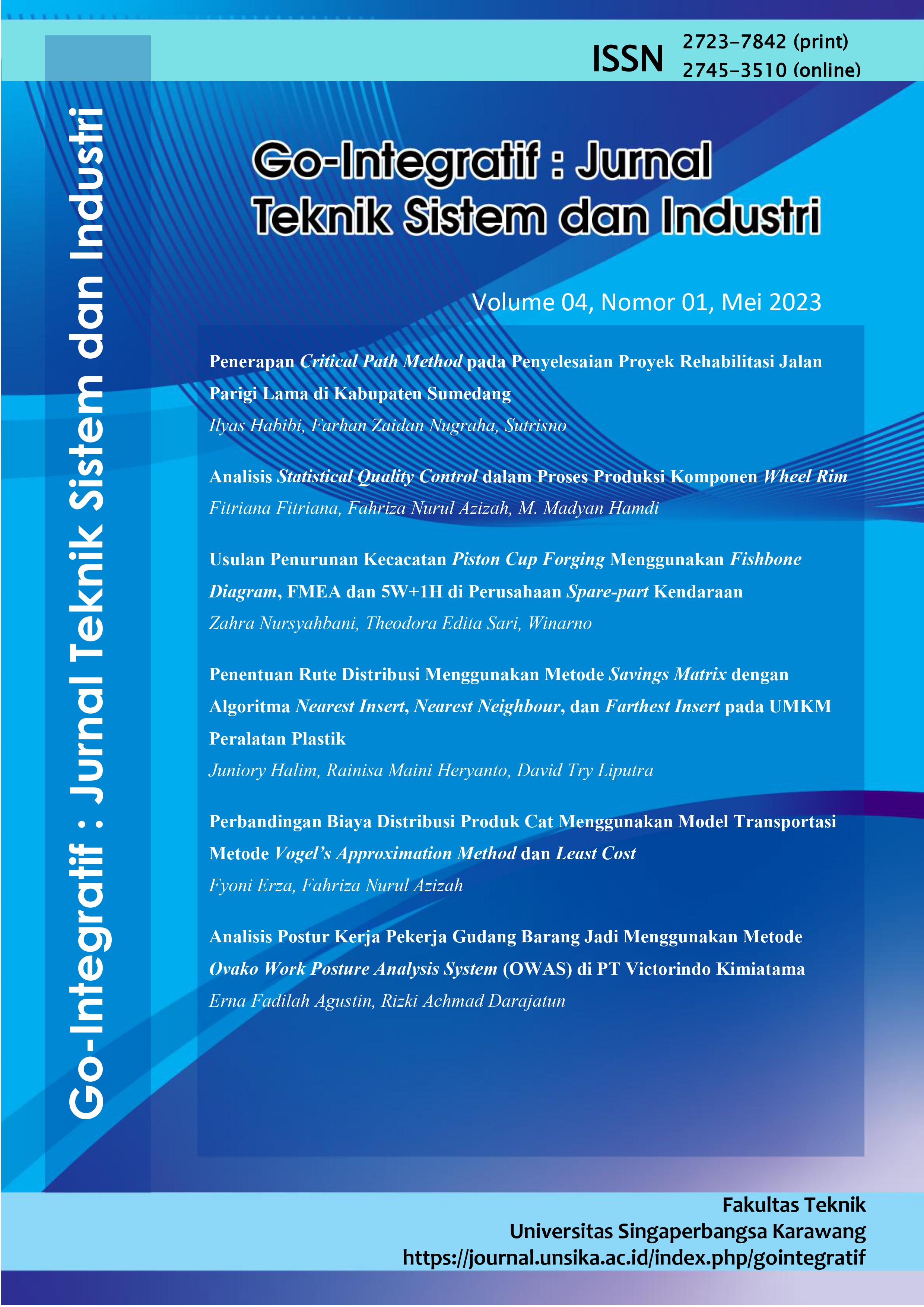Analisis Statistical Quality Control dalam Proses Produksi Komponen Wheel Rim
DOI:
https://doi.org/10.35261/gijtsi.v4i01.8778Abstrak
PT XYZ merupakan perusahaan yang bergerak di bidang usaha industri komponen otomotif wheel rim atau pelek kendaraan roda dua dan roda empat untuk pasar OEM domestik dan ekspor. Pada produk wheel rim yang dihasilkan PT XYZ selama periode satu bulan ditemukan sebanyak 255 unit produk yang cacat. Jenis kerusakan yang terjadi pada produk di antaranya pecah, slip, marking, dan ukuran tidak sesuai. Sehingga diperlukan penelitian dengan fokus pengendalian kualitas pada produk yang dihasilkan. Penelitian ini menggunakan metode Statistical Quality Control (SQC) untuk menganalisis tingkat kecacatan produk wheel rim dan faktor-faktor penyebab kerusakan produk sehingga perusahaan mendapatkan solusi dalam mengatasi kerusakan yang terjadi dan meningkatkan kualitas produk yang dihasilkan. Kategori cacat yang memiliki jumlah terbanyak yaitu cacat pecah (52%), dilanjutkan dengan ukuran tidak sesuai (31%), no marking (6%), mark terbalik (5%), terjepit (4%), dan slip (2%). Hasil penelitian menunjukkan fokus permasalahan pada perusahaan yaitu banyaknya produk cacat pecah dan ukuran produk yang tidak sesuai. Faktor manusia merupakan faktor utama yang mempengaruhi jumlah produk cacat, di mana kurangnya ketelitian dan tergesa-gesa membuat proses produksi tidak berjalan dengan baik.
Unduhan
Referensi
R. Ratnadi dan E. Suprianto, “Pengendalian Kualitas Produksi Menggunakan Alat Bantu Statistik (Seven Tools) dalam Upaya Menekan Tingkat Kerusakan Produk,” INDEPT (Jurnal Ind. Elektro dan Penerbangan), vol. 6, no. 2, pp. 10–18, 2020.
F. Tjiptono dan A. Diana, Total Quality Management. Yogyakarta: Penerbit Andi, 2001.
N. Nasution, Dasar-dasar Manajemen Produksi. Yogyakarta: BPFE Yogyakarta, 2015.
I. G. E. Dharsika, I. N. Budiartha, dan I. W. Yansen, “Analisis Kualitas Manajer Proyek Terhadap Pelaksanaan Proyek Kontruksi (Studi Kasus: di Denpasar dan Bandung),” J. Spektran, vol. 5, no. 1, pp. 11–18, 2017.
A. Puspasari, D. Mustomi, dan E. Anggraeni, “Proses Pengendalian Kualitas Produk Reject dalam Kualitas Kontrol pada PT. Yasufuku Indonesia Bekasi,” Widya Cipta, vol. 3, no. 1, pp. 71–78, 2019.
A. Nurdinia, S. Salmia, dan K. Kiswandono, “Pengendalian Kualitas Kerajinan Kayu dengan Statistical Quality Control (SQC) pada UD. Dua Putra-Putri,” J. Valtech (Jurnal Mhs. Tek. Ind., vol. 4, no. 1, pp. 7–12, 2021.
M. W. Wardhana, S. Sulastri, dan E. A. Kurniawan, “Analisis Peta Kendali Variabel pada Pengolahan Produk Minyak Sawit dengan Pendekatan Statistical Quality Control (SQC),” J. Rekayasa, Teknol. dan Sains, vol. 2, no. 1, pp. 27–34, 2018.
W. F. Insani dan F. N. Azizah, “Analisis Pengendalian Kualitas Produk Degan SK 150 Ml dengan Metode Statistical Quality Control (SQC) di PT Prima Kemasindo,” STRING (Satuan Tulisan Ris. dan Inov. Teknol., vol. 6, no. 3, pp. 217–226, 2022.
I. Khomah dan E. S. Rahayu, “Aplikasi Peta Kendali p Sebagai Pengendalian Kualitas Karet di PTPN IX Batujamus/Kerjoarum,” Agrar. J. Agribus. Rural Dev. Res., vol. 1, no. 1, pp. 12–24, 2015.
F. Mahira dan H. H. Hidayat, “Implementasi SQC (Statistical Quality Control) dalam Proses Pascapanen Tebu di PG. Madukismo,” STRING (Satuan Tulisan Ris. dan Inov. Teknol., vol. 7, no. 1, pp. 33–40, 2022.
R. Tri Basuki dan U. Amrina, “Pengendalian Kualitas Labelling pada Botol Oli Menggunakan Metode DMAIC di PT. Bumimulia Indah Lestari,” Go-Integratif J. Tek. Sist. dan Ind., vol. 3, no. 02, pp. 87–97, Nov. 2022, doi: 10.35261/gijtsi.v3i02.6942.
Unduhan
Diterbitkan
Cara Mengutip
Terbitan
Bagian
Lisensi
Hak Cipta (c) 2023 Fitriana, Fahriza, Dean

Artikel ini berlisensiCreative Commons Attribution-NonCommercial-ShareAlike 4.0 International License.



